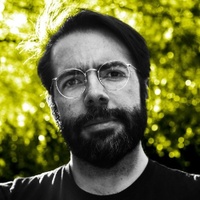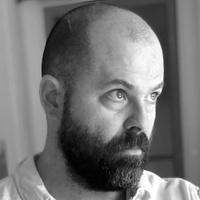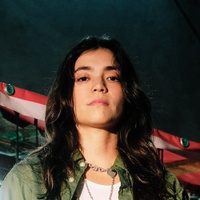As told to Sam Kusek, 2776 words.
Tags: Comics, Independence, Day jobs, Collaboration.
On leaning into inspiration
Comic book artist James Tynion IV discusses how he got his start, finding the right collaborators, and throwing away your road map.You’re celebrating your first decade of your independent work, so it’s only natural for me to ask: What advice do you wish you had 10 years ago?
The amazing thing is, that, or maybe amazing is the wrong word, but I think I always… I always had a kind of true north of what I wanted out of my independent work. At the start of my career, I was co-writing a lot of comics over at DC. I was working on the Batman titles over there, so I had my day job. Those were the projects that I was willing to compromise on. I was taking notes. I was learning how to do things.
Creator-owned work is where I knew that I would be able to tell the sorts of stories that really spoke to me and expressed who I was. At that moment in my career I was mostly working with other writers and stuff like that. I really didn’t have the opportunity to show people my personality and my core interests.
The main thing I was trying to figure out was who were the right partners who were going to back me in order to let me express that part of myself that I wasn’t able to express in my other work. So really the first two titles, The Woods and MEMETIC: THE APOCALYPTIC TRILOGY, through BOOM! Studios were the real apex of what I wanted to tell in that moment.
I knew I wanted to do horror stories. I knew I wanted to tell stories that tapped into the deep emotions that, in my early twenties, were still carried over from my high school years. There was a deep well of influences and pieces of myself that I wanted to express through comics, that were the entire reason that I was making comics. And once I realized that BOOM! was a home that was going to actually give me the opportunity to do it, I went all in. So I think my big piece of advice would be you need to find the partners who are going to let you tell your best work, and you need to listen to what you feel is your best work.
Getting a bit more into just the day-to-day, I want to talk about your process and how that’s changed and evolved over the years. I’m wondering, are there elements that you experimented with that ultimately stayed, things that you experimented with that dropped when it came to your writing or developing new titles?
Something I often point to The Woods about is the fact that I used to be the sort of writer that needed a very rigid outline. I needed to know what was happening in every single issue potentially years down the line, the kind of ridiculous long-form documents which editors have had to put up with from me for the entirety of my career. But at that early stage I was very much like, “The outline is the thing. I am going to stand by it. I am going to work with it.”
But it was over the course of writing the first year of The Woods that I realized that my outline was wrong and I realized, even more importantly, the character that I was building up to be the main villain of the series, the one that was going carry us through all 36 issues of the run, I realized that he needed to die in issue 12, and that I had no idea what was going to happen to the story after that. I had no idea, but it was the most interesting thing that could happen to the story and to each of the characters in the story.
And so at that moment I threw out the road map, and ever since then I’ve always been really hesitant about doing those kinds of super-detailed outlines, at least until I’m much further into a project. I always know what’s happening in the next few issues, but there’s always room to maneuver.
I always think of it in terms of a map, and you need to know the destination that you set out after and you need to be walking toward that destination and then the destination can change, but you always have to be walking in a direction on purpose. So as long as I know that, I can keep working. But it really is these early projects are me figuring out how I want to tell stories and they really are the blueprints for everything that I’ve done ever since in my career.
To that end, one of your most popular works, Something is Killing the Children, has a spin-off series, House of Slaughter, where you’ve stepped away from that sole author role and now you’re in this more director role working with multiple authors.
How does your process for plotting and directing differ from your process as the sole author? Is it similar in that you still have that north star that you’re walking to now you’re just more hand-in-hand? Or you’re pushing someone else in that direction and saying, “Hey, I need you to go over there.”
Well, I mean, every collaboration is a little bit different, but I think that the biggest thing that I provided with House of Slaughter is basically the rules in the world. They cannot break the rules and they cannot break the world. And there are certain elements that I’ve held on in terms of the core mythology for the main series in all of that.
But the amazing thing, especially both Tate Brombal and Sam Johns, they would come back to the table with these incredible ideas. I had several instances where I’ve said, “This is the general shape that I see this moving in.” And then they came back with better stuff and I was like, “Yeah, throw my stuff out. This is better. This is what the story should be.”
But as long as it all lives inside the world and the central aesthetics that I’ve created with Werther Dell’Edera, as long as it lives inside of that, it all feels a part of one big cohesive universe. And I think I learned a lot about how to work that way while doing the superhero work that I was talking about.
Yeah, there’s some fun parameters and guardrails to put up that still allow for a fair amount of flexibility. That’s a great place to get to.
So with your past few recent years you’ve spun up a lot of new series and, from the looks of it, you’ve got a lot more planned. I’m curious about how you start a project, especially when you’re working with a new collaborator.
So the early stages in a process are a little more solitary. Oftentimes I don’t know that I’m researching a project for months. I will be in a mode where I am, basically, I’m putting together all these…I’m reading a bunch of books and they’re all on one subject, and I haven’t quite put together why I am reading a bunch of books all on one subject.
But then, all of a sudden, I’ll be reading one of those books while listening to a strange album that is discordant with that book and suddenly an image or a scene or even a feeling just takes shape in my head. And those are the moments that I realize I have the seed for something that I want to explore.
But I try to lean into the central feeling of the thing and then the moment that I go out there finding the person I want to co-create this world with, it’s finding someone who I am going to be aligned with to tap into that central vibe and feeling because if we don’t agree on the central feeling of the story, then the story’s not going to work.
And then I find artists who I feel are going to tap into that and I ask them a lot of questions. And there’s a lot of back and forth because, basically, especially when you’re working on a long-form series, you’re saying, “Hey, we’re going to be, basically, in a relationship for the next two to five years.”
For a project like Something is Killing the Children, Werther is going to have to put up with me for a long, long time. But if we have that kind of commonality, and we have the same core pieces that we’re all really excited about, then we can really start to build something. And that build is the exciting part. It’s what I love the most.
Do you ever send any of those book recommendations or albums over to the artists, the collaborators?
Absolutely. I think that there’s always a fun back-and-forth there because that’s also when they start sending their recommendations. I remember I actually went out to Greece for a convention when Michael Dialynas and I were starting to talk about doing Wynd together. During the process of working on The Woods we would only see each other maybe once a year, and that process had started with us all through email and it was very early on. It was very early in my career. My process hadn’t really come together, but it was sitting and talking in a bar late at night about what we wanted out of building a fantasy world and what we didn’t want. And a lot of the original core pieces of Wynd were things that I had cooked up in a notebook when I was 16 years old.
But it was figuring out what was still exciting to both of us, what we could just throw away and the pieces that mattered. And it was there that we were talking about the nature spirits and how we wanted to tap into the idea of what would become Sprytles. And Michael was just drawing these things and we were talking about the core influences from Sprytles. I think a big one is the Kodama from Princess Mononoke. And so it’s just that kind of back-and-forth and that sort of trade, it creates a foundation that you can build on.
I know, and this just came up both in consuming media and that being an influence, that you watch a lot of movies when you aren’t working. Are there any specific genres that you return to, or, really, films that you return to?
I am a massive re-watcher. I like revisiting my touchstones and I think that there are different touchstones that I tap into for different projects. I think for the last few years, especially regarding my creator-owned work, you can see how often I’ve been revisiting my favorite David Fincher movies. I think that Fincher is hugely, hugely influential to me and the peak of that for me is probably Zodiac. But another one of my all-time favorite films is The Silence of the Lambs, which I watch at least once a year. Edward Scissorhands, Princess Mononoke…
With all of these, it’s about the story. It’s how they tap into the story of me, it’s the first time that I interacted with these things. So sometimes, to recapture a feeling of how I was at a moment in time, I will re-watch Edward Scissorhands and then I’ll rewatch the 20 other movies that I would’ve been watching around the same time to get myself back into the headspace of who I was then and who I am now.
A little visit to the past to reinforce your growth and who you are now.
I do the same thing with comics. All of my comic touchstones I revisit every time that I need to refill my tanks, creative tanks. Yeah.
So we’ve touched a lot on the past and your process. What are you hoping to accomplish in the next 10 years? What stones are left unturned?
Honestly, the biggest thing for me is I’m entering a new era of my career where I’m also a business owner. This is over the last year, we found financing for my independent brand, Tiny Onion. Now we’re expanding our capabilities which is allowing me to reinforce my independence and really focus on the actual creative work.
It’s the thing that now I get to build a project and then I go reach out to the different publishing partners that I’ve worked with over the years and it’s just like, “Are you the right home for this?” That is the part I honestly love, having those conversations. It allows me to really, really focus most on what I think the book should be, rather than what I think will get through an approval system. And it’s a much better place to stand from.
And then beyond that, I mean, I do have aspirations in other media. I never want to leave comics. Comics are everything to me, but I want to understand the filmmaking process a lot better, and I want to see what I can take from what I’ve learned making comics and bring it into that space.
The thing that I’m learning over and over and over is that I really do value a certain degree of independence and autonomy. And that becomes harder and harder when the budgets for these projects move up and up and up. But if I can find myself a space in the independent film world, that would be incredibly exciting to me. So that’s part of what I’m exploring with Tiny Onion right now.
Well, last question, in honor of your recently announced company, Tiny Onion, what is your favorite type of onion and favorite kind of preparation? Sauteed, pickled, mixed into a dip or salad?
Oh, boy. So many of the best onion dishes are the ones that you barely notice the onion.
It’s the ones like just a nice sauce where it fully caramelizes and you barely know it’s there. I will say some properly caramelized onions on a burger is always amazing. But one thing that I always think of is if you go to the Peter Luger Steak House in New York City they have this amazing steak sauce and they just serve it with a plate of raw onions and tomatoes to dip into the sauce. And it’s honestly amazing. And it is the only circumstances in which I would ever eat a raw onion. But it is just like, “You know what? This is… It works. I don’t know why it works, but it works, and it’s not something that I’ll be trying at home.”
James Tynion IV Recommends:
I’ve been particularly obsessed with the work of Agatha Christie lately. The books are so smartly constructed with such fascinating characters, and they can get brutally dark. I’ve been burning through them, but I highly recommend The Crooked House.
It’s the time of year where it’s very nice outside, and I am determined to take advantage of that. New York City is absolutely gorgeous in the late spring, early summer, before the humidity kicks in and ruins everything. I particularly love walking along the waterfront, and I think the view of the city from DUMBO is one of the most beautiful places on earth.
I’ve gotten into the habit of making cocktails, and I have to say that a dirty martini really is the perfect drink. Nice and salty, as many olives as they can legally give you. I like having mine with Beefeater Gin, but really the move is going to the bar at a classy steakhouse and going with whatever they have to give you.
So, I was a musical theater kid, and a Hot Topic Invader Zim-loving kid, and I went to catholic school, so it shouldn’t have surprised any of my friends when I had a few weeks of intense and powerful feelings about Hazbin Hotel earlier this year. If I had it when it was 15, it would have changed the course of my life.
I like comics of all shapes and sizes, but there’s some really exciting stuff happening in the indy/alternative space right now particularly from Silver Sprocket. I absolutely adore Caroline Cash’s Peepee Poopoo, which is Eisner nominated this year. This is one of those things that ten years from now you’ll want to brag to your friends about having read in the early days.




